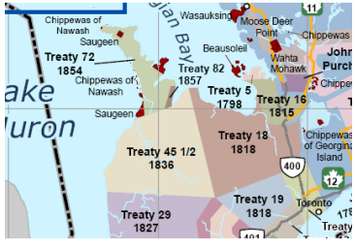A new report has concluded there is no historical evidence of distinct Métis communities capable of holding constitutionally protected Aboriginal rights within the territory of the Saugeen Ojibway Nation (SON).
The research was conducted by Dr. Heidi Bohaker, a Professor of History at the University of Toronto, and Dr. Chandra Murdoch, a Post-Doctoral Fellow at Osgoode Hall Law School. Their findings challenge the claims made by the Métis Nation of Ontario (MNO) and the Historic Saugeen Métis (HSM), both of which have asserted Aboriginal rights within the SON’s traditional territory.
According to the report, neither MNO nor HSM meet the legal criteria for Métis rights-holding communities as outlined in the Supreme Court of Canada’s 2003 R. v. Powley decision. That ruling established that in order to be recognized under section 35 of the Constitution Act, a Métis community must be a stable and identifiable group with a distinct collective identity and a shared way of life that predates effective European control of the area.
Leaders from SON say the new research affirms what they have long maintained.
"This report highlights what we have always known, that the Anishinaabe are the only people with rights and responsibilities in our Territory," said Chief Conrad Ritchie of Saugeen First Nation. "As Anishinaabe, we have an obligation to protect the land, waters, and resources of our Territory for our people, including from false claims by groups like MNO and HSM."
Chief Greg Nadjiwon of the Chippewas of Nawash Unceded First Nation also commented on the report.
"Governments and proponents who give credibility to these false claims cause real harm by diverting resources meant for First Nations," he said. "Living in a place is not the same thing as being Indigenous to a place. The evidence is crystal clear. We call on Canada and Ontario to stop enabling these groups and instead start negotiating with SON to protect our long-established rights."
SON has also reiterated past concerns about government and organizational engagement with MNO and HSM regarding activities in the territory. In a statement dated October 2023, SON leaders warned that such engagement enables false claims of cultural or historical connection to the land.
The statement addressed claims by MNO’s Georgian Bay Métis Council, which asserts harvesting rights in SON territory based on migration from Drummond Island and Penetanguishene, and HSM’s reliance on the "Piché Wampum of 1818" to justify its claims. According to SON, the Piché Wampum was a personal item with no authority to confer rights and offers no legitimate basis for HSM’s assertions.
SON leaders continue to call for governments and third parties to engage with their communities directly to uphold Indigenous rights grounded in treaty, history, and constitutional law.
The Saugeen Ojibway Nation is composed of two First Nations: the Saugeen First Nation and the Chippewas of Nawash Unceded First Nation. Their territory includes the Bruce (Saugeen) Peninsula, 1.5 million acres of land south of the peninsula, and surrounding waters in Lake Huron and Georgian Bay. SON is a Treaty partner with the Crown under Treaties 45 ½, 72, and others.






